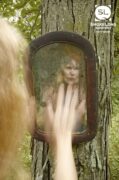Our protagonist seems to live in the tension between vigilance and resignation. The way she feels bound to hereditary illness reminded me of the force of prophecy in classics or Shakespeare. It’s in fascinating juxtaposition with the story’s very contemporary voice. I’m really curious about your inspiration for this story and how you came to style the prose?
I suppose in a lot of ways parents sit in this weird juxtaposition between ideas of fate vs. free will; nature vs. nurture. How much can I control and to what extent are we just fucked?
The inspiration for this story came out of my own experience as a mom with two young girls, both of whom have gone through bubble obsessions, so the first notions for this story grew out of that final scene: a mother standing at the window, watching as her daughter plays bubbles with an imaginary friend. And then I thought, well that’s nice, but that’s not a story. So the natural next leap is: How could I stir in some complication for this mom? That’s what story is, right—a character facing some kind of life-altering or perspective-altering situation? That’s what it needed. So then the grandmother in the psych ward came to mind and I realized, well, if a mom/grandma is in the psych ward with something like schizophrenia, then a daughter having an imaginary friend takes on a whole different level of meaning and concern. In terms of style, this woman’s way of narrating the world around her is rather transparently how I narrate the world around me, so part of this process was about letting myself step fully into her experience and combine our psyches.
To me, your story seems to trouble the boundaries between mental illness and more “ordinary” mental activity under stress or play (while acknowledging the reality of illness). One could read the beginning as the protagonist dissociating, in a way, from the upsetting call regarding her mother’s condition. As a writer, perhaps indebted to societally accepted but peculiar mental activities, what are your thoughts on categories of normalcy as they govern interiority?
Ah, yes, well questions of “normalcy” have long troubled me. What is “normal,” anyway? And again, I feel this story captures that very “normal” experience parents have of engaging in an internal struggle with the question, “Is that normal? ’cause it seems awfully damn weird to me.” I would guess that every single parent hits a moment when they’re like, I think my child might be pathological in some way. And so again, when you have a family history of something, whether that’s a mental illness or some other hereditary or genetic potential, you’re always keeping one ear cocked for the warning signs. And I think children are particularly primed to “trouble those boundaries,” as you’ve so aptly put it. As parents often joke, our children are born knowing exactly which tone of screaming we can’t stand to ignore, which buttons to push that we didn’t even know we had. And yes, I also wanted the mother to exhibit some symptoms that readers might attribute to her own mental break-down, but I wanted there to be ambiguity around that – is she genuinely disassociating or is she just a distracted, underslept and overworried parent?? Maybe some combination of all three?
Your use of words like “mindsick” and “whisperfast” struck me as traces of a secret language, the one we use in conversations with ourselves. It made me think that perhaps these conversations are what’s left when our imaginary friends recede? How did you come to these evocative words and what do they evoke for you?
You know, those words just kind of threw themselves together as a way this narrator relates to and experiences the world. The term “mindsick,” I feel, is particularly poignant for this narrator, because I don’t think she has the faculty to name her mother’s illness. She understands it as an illness, but she’s been hurt by it as well. Perhaps there’s a level of embarrassment, a holdover from her own childhood, which can’t have been easy, and this is another reason she needs to use alternative language. It’s her way of both acknowledging it while simultaneously holding it at a distance.
I’m fascinated by your title—“Argemina’s Revenge.” As far as the text goes, Argemina’s personality remains an unknown, but does accrue some menace. Fish-boy’s comment that it’s impossible to tell whether a pair of angelfish mean to kill each other felt ominous to me! Can you talk about the choice of titling the story around her and this specter of revenge?
Ha! Truth is, my daughter had gotten a new stuffed animal or doll or something, and she wanted to know what she should name it, and for some reason “Argemina” (Ar-guh-Mee-nah) came to mind. Try as I might, I could not convince her to name it Argemina and she ended up getting adorably pissed at me. After that, the name stuck with me, and I knew I was going to write a story titled “Argemina’s Revenge.” Actually, the title was there even before the bubble image, so in a way it’s about how a mother’s attempt to force expectations or desires on her daughter backfires on her. But I like the idea that Argemina may try to kill the daughter or the daughter will eventually need to kill Argemina (via: growing up, perhaps suppressing an actual hallucination with medication, or as my writers’ group questioned—maybe Argemina is actually real and the mom’s own mental illness is preventing her from seeing her).
Did you have an imaginary friend as a child?
No! I never did. But I tried once. Problem was, I knew she was imaginary, so I just couldn’t quite sell it to myself or anyone else. I loved imaginary play and would play alone in my room for hours, but for some reason imaginary friends just didn’t get a ticket to my show.



 The core workshop of SmokeLong Fitness is all in writing, so you can take part from anywhere at anytime. We are excited about creating a supportive, consistent and structured environment for flash writers to work on their craft in a community. We are thrilled and proud to say that our workshop participants have won, placed, or been listed in every major flash competition. Community works.
The core workshop of SmokeLong Fitness is all in writing, so you can take part from anywhere at anytime. We are excited about creating a supportive, consistent and structured environment for flash writers to work on their craft in a community. We are thrilled and proud to say that our workshop participants have won, placed, or been listed in every major flash competition. Community works.